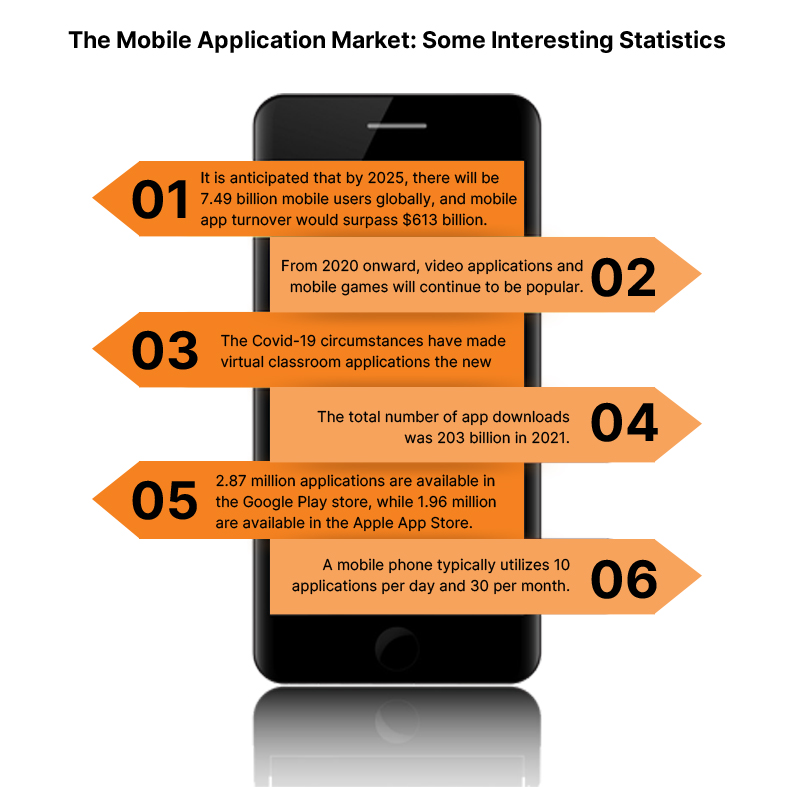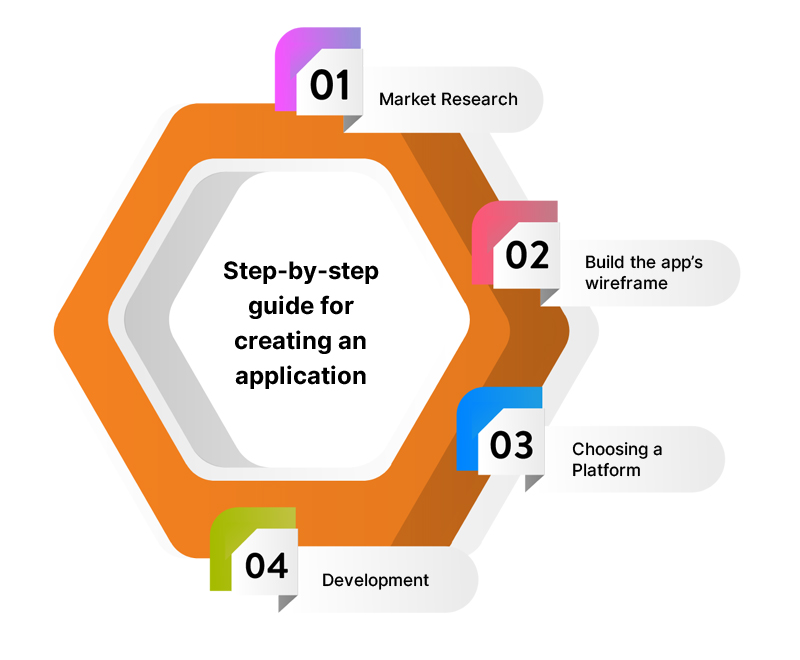If you’re developing a mobile app for the very first time for your startup, you might feel as though you’re sinking in a sea of constant advice.
Whether it be a podcast talking about UX metrics or blogs that refer to the profitability of outsourcing for startups, the options appear to be endless. It may be a bit intimidating as well and is likely to introduce some decision paralysis (FOMO).
-
- So how do you get started?
- A good idea?
- Okay, what happens next?
- Do you start by hiring developers for startup right away? Alternately, should you hire a consultant? Should you think about outsourcing mobile app development? Should you initially communicate your plan with the team? Before showing someone, why not try writing it down for better transparency? Do you prioritize appearance over features?
Take a deep breath.
We advise that you read this guide entirely from top to bottom.
Your app development project will go more smoothly and will be better planned if you have a clear understanding of the procedures required. Additionally, it will guarantee that none of the crucial procedures will slip your mind.

Before you start validating your idea and development process, you might want to consider some trends that you can leverage to build a feature-rich app.
-
-
- Predictive maintenance
- Facial recognition
- Categorization of images and texts
-
5 Emerging Trends That Will Propel Mobile App Development in 2022 and Beyond
Integrating the Internet of Things (IoT)
The Internet of Things (IoT) refers to a developing network of Internet-connected gadgets that provide users with ease and automation control. In 2022, the overall Internet of Things industry is estimated to reach $264 billion. This figure clearly shows that IoT is not a novel phenomenon. However, the surge in mobile penetration throughout a wide range of industries and categories has produced what appears to be an infinite amount of possibilities for the IoT.
Beacon Technology
2013 saw the development of the first phone application using Beacon technology. However, it has seen tremendous growth since. Statista reports that the industry for beacon technology is expanding at a pace of 59.8% annualized. An extensive spectrum of industries has welcomed beacon technology. Proximity marketing is the key advantage of beacon technology. Additionally, it enhances practically any mobile application’s usefulness in retail, medicine, and hospitality.
Application for Foldable Phones
As per Statista, foldable phones are anticipated to sell 50 million units by 2022. Therefore, application developers need to make the necessary arrangements as 2022 will undoubtedly be a significant year for foldable. Many businesses are thus continuously attempting to create apps that perfectly fit and adapt to a screen that will fold and unfold.
Artificial Intelligence
Apps can get wiser thanks to artificial intelligence, eventually improving their overall functionality. In 2022, AI will alter every aspect of developing applications, from the backend programming to the UI.
The following are some examples of Ai technologies that may be included in a smartphone application:
-
-
- Image identification
- Identification and categorization of emotions
- Speech synthesis
-
Chatbots
Chatbots have improved significantly over time and are now considerably more powerful. The use of chatbots on apps has grown as a result of customer demand. It’s evolving into the new benchmark for customer care. As a result, the worldwide chatbot market is expanding by 24% annually. With chatbots, your app will become more interactive and improve overall user satisfaction.
Now that you know all the latest features and technologies that are thriving in the industry, it is time to start the development process. For this, you will first need to recruit a development team. There are multiple things you should consider while choosing a development team. A good team will not only understand your business needs but also work with you to fulfill them.
You start by deciding on how to move forward. Here are two ways:
-
-
- Build your internal team
- Outsource from experts
-
Validate the App Idea
Before moving forward with the development process, validate the app idea so that you identify your intended audience and pain points.
App validation can start from you tinkering with:
1. The problem that you are looking to solve
-
-
- What kind of scope would the app have?
- What kind of users would be using the app?
- What would be the appeal?
-
2. Audience and user research
-
-
- Creation of proto personas
-
3. Creating the customer journey
The app validation process would enable you to ascertain the utility of the app and its relevance in the marketplace.
Now you are all set to kickstart the development process. Follow these steps thoroughly, and your full-fledged app will be in your hand.
Step-by-Step Guide for Creating an Application

1. Market Research
Firstly, you need to take the most crucial step: Conduct Market Research. Market research reveals the actual needs or enthusiasm of the market. As a result, you can change your concept as needed, and it may provide you with a detailed list of criteria that will assist you in setting priorities for the task. But that’s not all. Here are a few other benefits you will see by conducting market research.
-
-
- It aids in a greater understanding of your clients.
- Allows you to learn about your rivals.
- Aids in properly evaluating your goods before launch.
- Aids in defining the best way to contact the target audience
- Analyzes the economic benefits.
- Find out what features are available and what the people want.
-
2. Build the App’s Wireframe
You may now begin the process of creating wireframes for your concept. This may serve as the application’s design guide. It will showcase the appearance and features of your application.
The following are a few procedures you should think about taking in order to generate wireframes:
-
-
- By understanding the client’s needs and developing solutions appropriately, outline the workflow of the app.
- Creating a mobile frame that precisely matches the look of the device, whether it runs an iOS or an Android app.
- Use well-known designs in your work. Customers enjoy using your website more when they see familiar patterns.
-
-
-
- Design sprints are essential for avoiding conflicts among designed frames. They could be employed to develop a new service, remodel a current product, or even integrate new features into an existing one.
-
3. Choosing a Platform
Now you have to choose a platform that will perfectly align with your needs. Here are three mobile application platforms that are thriving in the market.
-
-
- Native App
-
Developers can develop a mobile app for a particular platform, such as Android or iOS, with the aid of a programming language and toolset.
-
-
- Cross-platform or Hybrid Apps:
-
HTML5-based mobile application that works across several platforms. Just like native apps, they may be obtained from all app stores.
-
-
- HTML5 Web App
-
It is essentially a website that has been customized to seem like a native app and is used on a mobile browser. The capabilities and consumer experience of this online application, which is platform-independent, are outstanding. It is best to build applications in instances in which either the app store specifically forbids it or when it is not anticipated that consumers will be attracted to download it.
4. Development
The moment has come to offer your dream application a suitable framework. The actual implementation of the app, as well as the coding portion, is covered by this procedure. Producing a mobile app involves a variety of tasks, including startup MVP development, setting up a suitable programming environment, writing various sections of code, doing exploratory testing, and building an application capable of being downloaded and tested.
Backend
When the application connects to the internet, database and server-side objects become essential for supporting functionality. If you’re utilizing a backend system that already exists, adjustments and modifications may be required to provide the necessary mobile app capabilities. The application’s additional elements need to be tested and built using the server-side objects created during this phase.
Application Programming Interface
An API is a collection of standards, procedures, and resources for creating software programs. It describes the relationships between software parts. The programming interface is also used to create GUI elements.
Mobile App Front-End
Users of your mobile application engage with the front-end. This is why this is known as “client-side” programming. Whenever you launch webpages, online applications, or mobile apps, it executes the necessary structure, layout, animations, and activity that users can view on the screen. It is important not only to design attractive user interfaces but also to ensure that the viewers are able to navigate the application easily.
Test and Make Improvements
Launching a bug-free application is crucial; therefore, testing as a significant impact. There is a probability that by evaluating the code, the app’s quality will be enhanced, which may also assist organizations in cutting costs, labor, and effort.
The following are several testing steps that you need to do:
-
-
- Documentation Testing: The first testing phase is used to ensure that all desired functionalities are present and any inconsistencies are addressed.
- Functional Testing: It evaluates the performance of mobile applications. The application’s intended market, business sectors, and distribution channels like Google Play and the App Store must be considered.
- Usability Testing: This type of testing involves ensuring that your users will have an amazing experience using the application and that it offers a seamless browsing experience. The app’s usefulness, speed, and user experience may all be evaluated in this.
- User Interface Testing: To ensure that it satisfies the necessary requirements, the GUI is tested.
- Compatibility Testing: This evaluates how well the program is configured or compatible. It also looks at the operating system, browsers, databases, devices, and networks.
- Performance Testing: You may use it to determine whether software can function when faced with particular difficulties.
- Security Testing: The action is taken to strengthen the app’s security. Additionally, it identifies and addresses any hazards or hacking potential.
- Certification Testing: Testing for certification is done to ensure the software complies with license requirements and industry norms.
-
5. Launch the Beta Version
Younger generations might be attracted to the beta version. They may provide you with an opinion on the advantages and disadvantages, which you can then put into practice. You can evaluate their reviews and experiences to better grasp the demands of the current clientele.
Depending on the feedback received on the beta version, you can build the final version of the application and submit it to the play store and app store. The submission process is different in the play store and app store.
The Process for Submitting an App to The App Store and Google Play Store
The procedure for publishing an app on the Google Play Store:
-
-
- Prepare the data for the mobile app.
- Submit the APK or mobile app bundle documents.
- Put a category rating on the application.
- Set the price for the app.
- Plan your distribution strategy.
- Make your application public.
-
The procedure for publishing an app on the The App Store:
-
-
- Build an iOS distributing certificate and profile.
- Make a record on iTunes Connect for the application.
- Archive and submit the mobile app using Xcode.
- Modify metadata as well as other information for the app in the iTunes Connect record.
- Submit your request for consideration.
- Look at the application’s status.
-
Over to You
With Netsmartz, outsource your mobile app development with the help of our offshore, seasoned professionals. Need dedicated app developers who only work on your project? We have them. With our 20+ years of experience, we have several skilled professionals worldwide who can work with you on your project. You only need a viable concept and effective business strategy. If you have an app idea, book a free consultation NOW!
Summary
Kickstart Your Project With Us!
Blog
Popular Posts
CONTACT US
Let's Build Your Agile Team.
Experience Netsmartz for 40 hours - No Cost, No Obligation.
Connect With Us Today!
Please fill out the form or send us an email to
 Don't Miss Out:
Don't Miss Out: 







